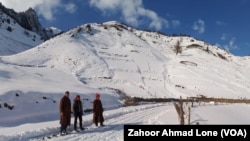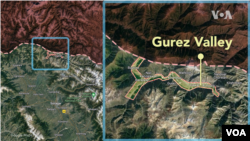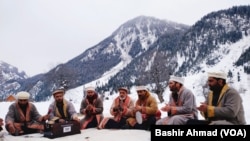For the 37,000 inhabitants of the Gurez Valley in Indian-administered Kashmir, winter is a time to get out or hunker down.
Nestled high in the Himalayas, the valley has only one road link to the outside world and that is closed by deep snow for almost six months of the year, leaving the residents no way in or out except by helicopter for medical and other emergencies.
More than half the residents — about 20,000 this year — chose to leave. For the rest, winter means settling into their homes in the valley’s 27 villages with a stockpile of canned goods, dried vegetables and firewood or coal, and waiting patiently for spring to arrive.
The long months of isolation are passed by working on handicrafts for sale the following summer, listening to Kashmiri music, feeding cattle and visiting each other. A limited amount of provisions are available at the valley’s stores, which stockpile huge quantities of non-perishable goods every fall.
For many of the residents, the greatest concern over the long winter is health care, which is overseen by 20 medical officers who handle most day-to-day issues from a network of primary and community health centers.
“It is difficult to live in extreme winters as the valley gets inaccessible through road and air connectivity is the only means to move out of Gurez. In a medical emergency, the valley lacks a proper health care system,” lamented Abdul Majeed, a longtime resident.
He said the valley’s 11 ambulances often have trouble navigating the roads in winter and airlifting patients to hospitals outside the valley is not always possible.
Dr. Tahira Nazir, the medical officer at a community health center who has been serving in Gurez for over a decade, told VOA that she and her medical team do the best they can with the limited resources at their disposal, but bemoaned the lack of a blood bank and noted that this winter the valley is lacking three specialists — a physician, a gynecologist and a pediatrician.
“I have informed the administration about this and until recently, we had a gynecologist on a rotation basis here; however, the replacement is yet to join,” she said.
Dr. Mir Mushtaq, spokesperson for the director of Health Services Kashmir, said in an interview that authorities stockpile adequate medical supplies in snowbound areas to last through the winter.
“We airlift patients to the nearby hospitals in case of emergency,” he added, noting that the department has recently issued an order deputizing eight gynecologists to the Gurez valley.
Their arrival will be too late for some of the residents.
Noorani Begum, a 60-year-old grandmother, told VOA that she delivered all her seven children at home without modern medical intervention but that her elder daughter’s pregnancy was not that easy. She was shifted before winter to Srinagar, Kashmir’s summer capital, because there was no gynecologist available in the valley at that time.
“Fearing road closure and on doctor’s advice, we had to move out of Gurez for my daughter’s pregnancy,” said Begum. “It was an expensive affair for us as the four family members had to stay in Srinagar near Lal Ded Hospital for six months. We sold cattle to manage our expenses and took some loan[s] as well.”
Another challenge: Keeping warm
Electricity shortages are another chronic problem in the winter, despite the completion in 2018 of a major hydroelectric power plant on the Kishanganga River, which runs through the valley.
The 330-megawatt plant is an important source of energy for the Indian power grid but not enough is fed back into the valley to light and heat its homes, leaving the residents to rely on diesel generators in their villages supplemented by firewood and coal to keep them warm.
Frustration at the situation is compounded by lingering anger over the construction of the dam, which impacted an estimated 610 residents and 171 families amid complaints about poor prices paid for confiscated land and broken promises about jobs.
Residents stay warm by staying close
Despite the problems and hardships, residents of the valley — especially the elderly — have developed resilience and accepted the challenges over the decades.
“Warmth inside our hearts survives us and we sometimes arrange get-togethers,” said Bashir Ahmad Teroo, a health department employee who has turned a portion of his house into a museum preserving antiques from Gurez.
“The songs and dance[s] reverberate [through] the whole valley even during the freezing weather.”












